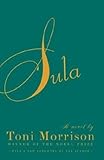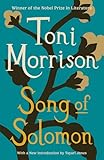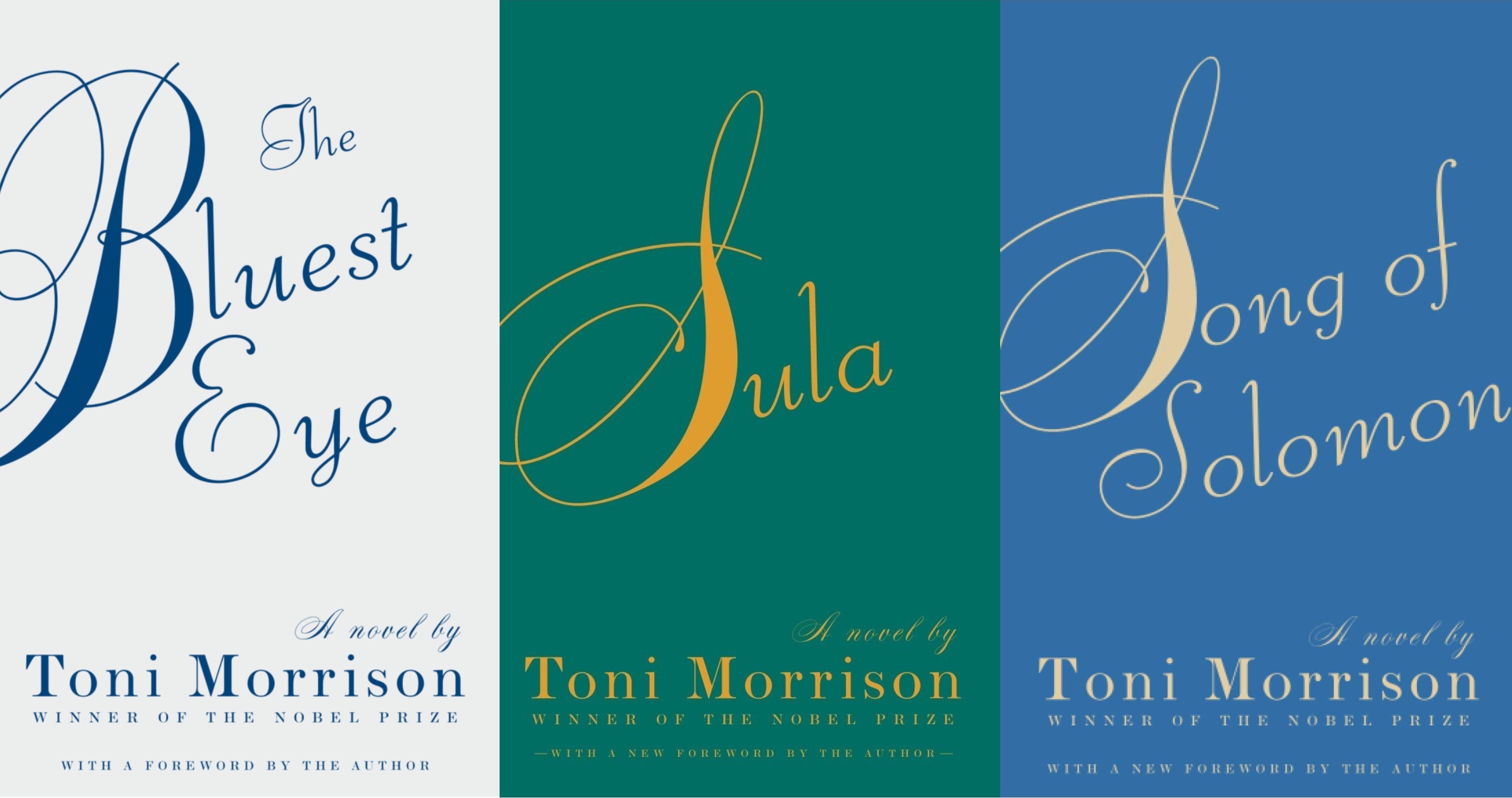I love reading writers’ works in chronological order. Especially with great novelists, it’s so satisfying to see the seeds of later masterpieces in early works. What I often notice is that writers experiment widely with different genres, styles, and narrative perspectives as they work to find a unique voice at the start of their career. Fyodor Dostoevsky’s first three novels, for example, include an epistolary social critique, a surrealist nightmare, and a Dickensian bildungsroman.
Reading Toni Morrison’s books, I’m finding a stark contrast. She does not leap from one kind of story to something radically different, like a pendulum trying to find equilibrium. Morrison’s voice shines through from the beginning. Her books contain vastly different plots and characters, but they all bear the marks of her imagination, style, and insight.
 In Timothy Greenfields-Sanders’s powerful 2019 documentary about Morrison, The Pieces I Am, the interviewees frequently described Morrison as expanding her canvas with each work. I decided to read through all her novels and, after finishing the first three, I already understand what they meant. These early works do not merely anticipate masterpieces to come; they are masterpieces in their own right. Examining just how each novel expands on what came before is an inspiring and, frankly, humbling experience. And it all begins with The Bluest Eye.
In Timothy Greenfields-Sanders’s powerful 2019 documentary about Morrison, The Pieces I Am, the interviewees frequently described Morrison as expanding her canvas with each work. I decided to read through all her novels and, after finishing the first three, I already understand what they meant. These early works do not merely anticipate masterpieces to come; they are masterpieces in their own right. Examining just how each novel expands on what came before is an inspiring and, frankly, humbling experience. And it all begins with The Bluest Eye.
 1.
1.
In the afterword to The Bluest Eye, Morrison traces the novel back to a haunting conversation from her childhood. One of her friends confided that she wanted blue eyes, a wish that disturbed Morrison because, “Implicit in her desire was racial self-loathing.” “Twenty years later.” Morrison reflects, “ I was still wondering about how one learns that.” The Bluest Eye directly responds to the systemic oppression that informed her friend’s desire by “peck[ing] away at the gaze that condemned her.”
Morrison demonstrates a keen understanding of what a novel can accomplish in just the first few pages of The Bluest Eye. In essence, the opening functions as an outline of every major plot point to come. By beginning this way Morrison spoils the ending to her own story, revealing the ultimate fate of the novel’s central character, Pecola Breedlove. But this isn’t a story whose power relies on maintaining suspense. It cannot be spoiled because it is not about what happened. It is not even about why things happened the way they did because, as the unknown narrator of the prologue tells us, “why is difficult to handle.” Instead, we “must take refuge in how.”
This elevation of how over why is a defining feature not only of The Bluest Eye, but of Morrison’s subsequent two novels. She does not make it easy for us by giving us straightforward answers or even straightforward questions. Instead we simply inhabit and perceive Morrison’s richly developed world through the eyes of characters as real as any person you could meet. This is something that can only be accomplished through fiction.
Her ability to effortlessly transport us from one consciousness to another (and often from one time period to another) allows us to simultaneously perceive everything that happens from a variety of viewpoints. This does not mean we always agree or even sympathize with the characters. But Morrison does not give us the comfort of seeing any of them as villains. She is too good a writer for readers to be left not understanding anyone. The true enemies, in any case, resist easy forms or definitions. Like the insidious gaze that filled Morrison’s friend with shame, they pollute the characters’ world through systems of oppression no single person is responsible for creating.
This identification of the true villain as something systemic and pervasive is made explicit at the end of a scene where three Black girls, Celia, Frieda, and Pecola, and a white girl named Maureen Peal get into an argument. Maureen eventually storms off and declares, “I am cute! And you ugly! Black and ugly…!” Celia is enraged, but admits that, “all the time we knew that Maureen Peal was not the Enemy and not worthy of such intense hatred. The Thing to fear was the Thing that made her beautiful, and not us.”
This scene exemplifies another one of Morrison’s strengths: her ability to write scenes that could function as powerful short stories entirely separate from the novel. In part this is due to Morrison’s tendency to switch perspectives with each chapter. She switches between time periods as well. The beginning of one chapter might take place decades before or after the last one ended. But The Bluest Eye never feels like a short story collection passing itself off as a novel. The further into the story you get, the more you see how Morrison weaves each episode together into a potent, deeply affecting whole. Morrison achieves this in many subtle ways, but one obvious method is by having each incident shape the life of one particular character, Pecola.
Earlier I called Pecola the central character of The Bluest Eye as opposed to the main one. That is because it’s hard to think of her as a main anything. Pecola is always on the receiving end of other characters’ neglect, abuse, or attempts at love. She is only allowed a chance to speak for herself at the very end, and by this point her psyche is so fractured that we end up with more of a hallucinatory dialogue than a clear perspective. Even the title emphasizes not Pecola herself but something she does not and will never have. The Bluest Eye is not so much about Pecola than about how others’ choices drive her inexorably towards tragedy.
Pecola is frequently a recurring background character while someone else narrates, but she is invariably the one who suffers most. One devastating instance comes when Celia and Frieda visit Pecola at the house where Mrs. Breedlove, her mother, works as a maid. The scene ends with Pecola being beaten by her mother after the girls accidentally knock over a pie Mrs. Breedlove made, dirtying the floor she had just cleaned in the process. What compounds the emotional toll of this moment is the presence of Mrs. Breedlove’s employer’s white daughter. The toddler is horrified when these three girls she has never met before ruin the delicious pie meant for her. Mrs. Breedlove responds by gently comforting the white child right after beating her own. She does not even acknowledge Pecola as her own daughter. The racial dynamics at play here are as complex as they are heartbreaking, illustrating Morrison’s wisdom in thoroughly telling us how and leaving the trickier why for us to contemplate on our own.
The Bluest Eye demonstrates Morrison’s already impressive command over her craft, especially through her use of different styles. She would eventually demonstrate these same strengths with her third novel, Song of Solomon. In between the two lays Sula.
 2.
2.
When considering Sula, Dostoevsky once again provides a useful contrast. In one of his letters, he told a friend that after writing about a guilty man in Crime and Punishment, he wanted to portray a purely innocent man in his next novel, The Idiot. Whether Morrison consciously saw Sula as the “opposite” of The Bluest Eye, the central figures at least are indeed polar opposites. The Bluest Eye, as mentioned earlier, refers to Pecola by way of by emphasizing what she does not have. The title Sula foregrounds the character Sula Peace, who looms over everything and everyone in the novel, even when she isn’t present. If The Bluest Eye is about how others’ choices impact Pecola, Sula is about how Sula’s choices impact others.
This is more than just the story of a different kind of character, however. First, it arguably has two central figures, Sula and her friend, the far less independent Nel Wright. But second, and more importantly, this is a story about a community as much as the people living in it. The first three lines make this clear beyond any doubt:
In that place, where they tore the nightshade and blackberry patches from their roots to make room for the Medallion City Golf Course, there was once a neighborhood. It stood in the hills above the alley town of Medallion and spread all the way to the river. It is called the suburbs now, but when black people lived there it was called the Bottom.
Both of Morrison’s first two novels open by looking back at something lost. In The Bluest Eye, it is an innocent time that disappeared after Pecola’s trauma. In Sula, Morrison prioritizes the loss of a place. And while places cannot literally die, there is something funereal about a place with a name being erased for the sake of a golf course and bland suburbs that undoubtedly looks like a thousand others. In both cases, an identity has been destroyed.
The interrelatedness of the Bottom’s inhabitants is made clear again and again. No major event affects just one person. Large crowds are often involved or at least present when such events occur. Generations also influence the lives of old and young alike. By the end of the novel, we have witnessed three generations whose triumphs and tragedies ineluctably shape those around them, even if the full ramifications of one action do not come until decades after. As strange as it may sound, I found myself thinking of Icelandic sagas. The plots of both Sula and these ancient narratives are deeply influenced by communities and the legacies of generations past. The actions of distant ancestors are so great that the titular hero sometimes doesn’t appear until a third of the way through the saga. Notably, Sula is not mentioned until around page 30 and it takes another 30 pages for Sula to take any action of her own in a novel named Sula.
Sula faces isolation more than once, but remains forever tied to her friend Nel. Both actually begin in an isolated state, which is why, “Their meeting was fortunate, for it let them use each other to grow on. Daughters of distant mothers and incomprehensible fathers…they found in each other’s eyes the intimacy they were looking for.”
The characters complement each other in a way only opposites could. Nel is far more insecure, lacks the courage to ever leave the Bottom, and eventually surrenders to the kind of life expected of her. This comes as no surprise, since “Her parents had succeeded in rubbing down to a dull glow any sparkle or splutter she had.” She is infected by a trace of racial self-loathing, too, though in this case it appears in the form of language. Nel has family who speak Creole, but when Nel asks about the language, her mother curtly replies, “I don’t talk Creole,” adding, “And neither do you.”\
Sula, on the other hand, is a force of nature her entire life. Unlike Nel, or anyone else in the Bottom, she has the audacity to leave. She passes through over half a dozen cities before returning home to find herself a dreaded larger-than-life figure. She is believed to possess supernatural powers. There are also rumors that she slept with white men, something the people of the Bottom consider unforgivable. But no one is more affected by Sula’s return than Nel, whose ordered world is soon plunged into chaos.
Sula certainly expands on The Bluest Eye. But that expansion is nothing compared to what came next.
 3.
3.
Song of Solomon is a neutron star of a novel. It contains so many riveting characters, so many rich family histories, so any folktales and songs, and so many pieces of U.S. history yet manages to be less than four hundred pages.
The novel begins with an insurance salesman deciding to fly from the top of a North Carolina hospital to Lake Superior. Spoiler: he fails. The birth of the main character of Song of Solomon, Milkman Dead, coincides with the salesman’s suicide. “Milkman” is actually a nickname that derives from an early scene that highlights how his mother clings to her son in the face of a loveless marriage and the absence of her beloved father. His actual name is Macon Dead III. “Macon” and “Dead,” derive from an indifferent white man who misunderstands Macon’s grandfather shortly after slavery ends.
The next two thirds of the novel exhibit all of Morrison’s by now trademark strengths. We move from one time and consciousness to another, which lets us learn about each of Milkman’s family members. Their incongruous perceptions of each other put the reader in the role of a detective. Milkman, however, is undoubtedly the protagonist, and is the first one I worried I would not like. He initially seems to function purely as a way for us to get to know others because there is not much to know about him. He is aimless, lacks any ambition, and has a limited conception of the world, unlike his politically-informed friend, Guitar. The contrast between the two men calls to mind the differences between Nel and Sula.
Then we reach Part II and everything changes. The story becomes a literal search for buried treasure that in turn expands into a quest for his family’s history. Previously Milkman only experienced his family’s past through memories that may or may not be trusted. Now he goes to the actual places where these stories happened. It is a deeply satisfying twist in three ways. First, it builds on what we learned in Part I in unexpected ways. Second, Milkman does not simply gather up facts about his ancestors. He must piece together stories and folktales and the songs, including the “song of Solomon” to discover a deeply personal truth. And third, Milkman’s quest for a sense of belonging becomes symbolic of an entire people searching for their roots.
History has never been so present in Morrison’s early works. The murder of Emmett Till is directly referenced, as is Malcolm X, and the horrors faced by Black Americans are brought up time and again, including in a particularly fascinating dialogue about the secretive Seven Days organization between Milkman and Guitar. Morrison has never ignored the brutal realities of racism and the terror white people inflict on Black lives. There are multiple scenes in her first two novels that involve white people that are unbearably tense, even in situations that seem relatively safe for the characters. For example, in The Bluest Eye, Pecola’s father is, as a young man, forced to have sex with a girl in front of white men. It’s clear his life is in danger if he does not perform for them. In Sula, Nel and her mother accidentally get onto a white’s only section of a train. They hurry out, but not before they are noticed. This second example seems to have less dramatic stakes, but the depressing fact is that any time a white character appears, we as readers know they can do anything, no matter how vile, with total impunity.
Song of Solomon is different. The first two novels included occasional intrusions into Black worlds (worlds that are, of course, shaped by the United States’ virulent racism). The toxic reality of racism feels more pervasive in this third novel, something that the characters must contend with constantly. It is also addressed more directly and philosophically by characters than before, who consequently take drastically different paths in life. This unfortunately results in divisions among family and friends, the most painful of which occurs between Milkman and Guitar. But the divide between these two men does not come about by betrayal, as with Nel and Sula. Rather, it is a gradual process, accelerated by a misunderstanding with fatal consequences.
Song of Solomon begins with one man falling and ends with another learning to fly. But this spoils nothing. Like The Bluest Eye and Sula, this is a story about how. And that how is beautiful.
4.
These three novels are a testament to Morrison’s selflessness as a writer. The Bluest Eye alone is proof of this. Not only was it a reckoning with the cruel gaze that made her friend doubt her own inherent beauty. Morrison also explains in The Pieces I Am that she wanted to write specifically for a Black audience. She felt even writers like Frederick Douglass ultimately had a white audience in mind. Her novels would be different so that her readers would know someone was speaking to them. Furthermore, they would take place in worlds that were not defined by the white gaze or any white person’s preconceptions. Her novels’ worlds would be outside the white gaze entirely. The Bluest Eye, Sula, and Song of Solomon show an author with a commanding, distinctive voice, even as Morrison also gives voice to generations of Black Americans who struggle even today to be heard at all.
As a white man, I know I am not the audience Morrison imagined. But I am grateful for all I’ve learned from reading these three novels. They have exposed me to perspectives and ideas I never would have discovered otherwise. Researching them has also led me to other great writers I undoubtedly have just as much to learn from.
And best of all, I still have eight more Morrison novels to read.



